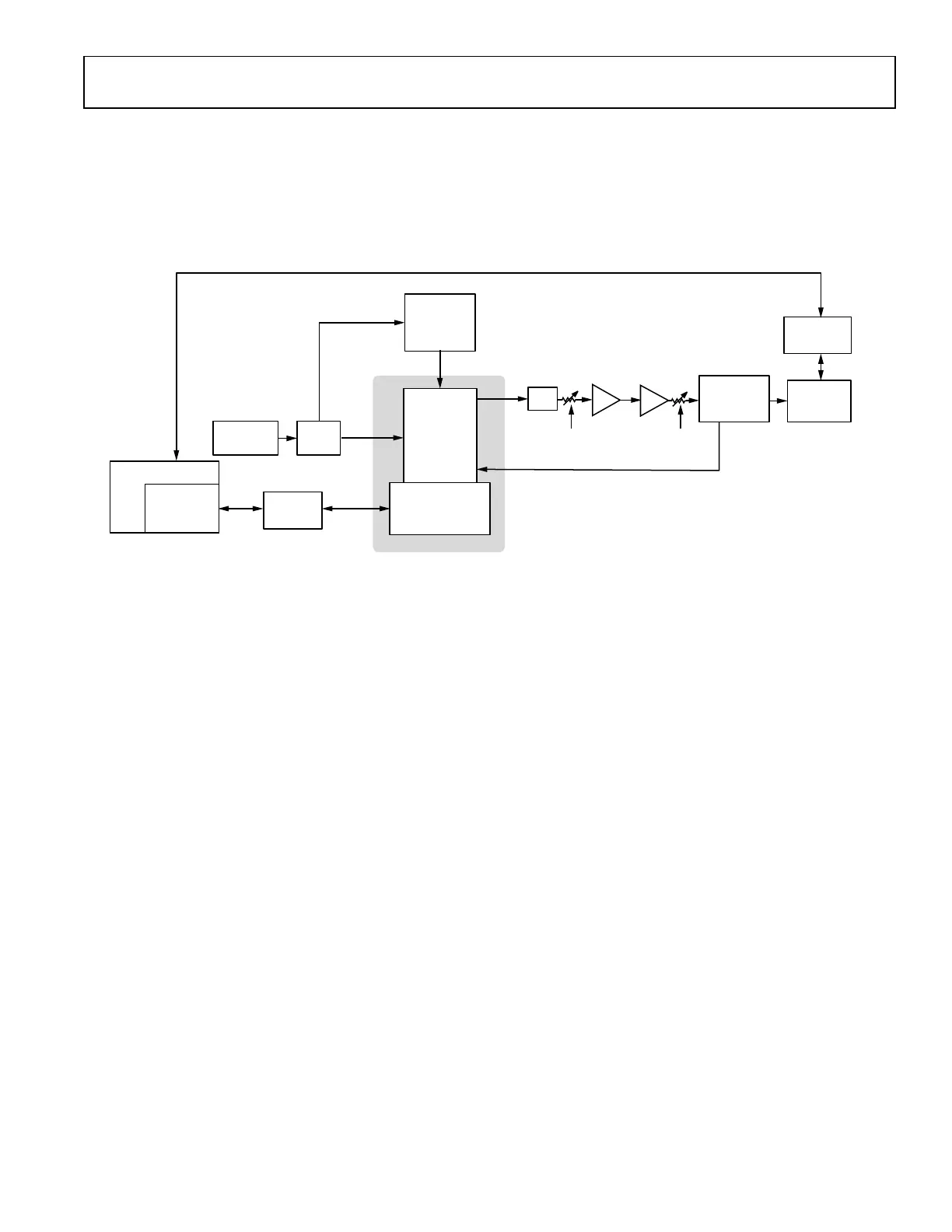Preliminary Technical Data UG-1828
Rev. PrC | Page 213 of 338
driver has an internal LPF, then the external LPF is not needed). Since the device uses square wave mixer, it produces strong odd-order
harmonics. Without filtering those harmonics, the DPD performance could be impacted. The step attenuators external to the ADRV9001
evaluation board are optional. Note it is important to set up the external loopback path before operating the integrated DPD. To achieve
optimal DPD performance for TETRA waveforms, it is recommended to use an external LO source for transmitter due to possible better
phase noise performance, while the receiver LO remains internal because the RF receive signal is downconverted to an IF instead of
directly to baseband. For WB applications, the setup is similar but both transmitter and receiver LOs could be set to be internal because a
WB signal is less sensitive to phase noise. A spectrum analyzer can be set up to observe the ACPR performance during a DPD operation.
Figure 198. An Example Setup for Testing the Integrated DPD in Narrowband Applications
Once the setup is ready, user should further configure the TES and available external components properly which includes the following
major steps:
• Select desired profile.
• Perform board configuration to indicate external loopback path with external PA is available.
• Enter the peak power of the loopback signal (ideally, it should be adjusted to be -18dBm±5dB. This could be achieved by tuning the
external step attenuator).
• Measure the external loopback delay and provide it through TES. This could be done through API commands which will be
discussed at the end of this section.
• Configure other initialization parameters such as RF frequency, LO source, and so on as desired. Also, enabling DPD for transmitter
and configure the model tap polynomial terms. It is recommended to start with the default model tap. (The method of tuning the
model tap order will be discussed in the next section.)
• Turn on DPD tracking calibration and all the other available tracking calibrations and start with the default DPD post calibration
parameter settings provided in TES.
• After programming, load, and play the provided sample transmit input file.
• Properly tune the transmitter attenuation and/or the step attenuator to make sure that the ACPR performance at the device
transmitter output is satisfactory before passing to PA. In addition, make sure that the transmit peak signal is around P1dB
compression region for optimal DPD performance.
The user could compare the ACPR performance through spectrum analyzer with and without using the integrated DPD. Significant
ACPR performance improvement with the integrated DPD should be observed even with internal LO sources. For TETRA waveforms,
the ACPR after the second iteration of DPD is between −70 dB and −60 dB at an amplifier compression of P1dB. For LTE waveforms, the
ACPR after the second iteration of DPD is between −55 dB and −50 dB at an amplifier compression of P1dB.
Tuning the Model Tap Order
DPD can be considered as an adaptive filter which is modelled according to the behavior of the PA. As mentioned previously, the
ADRV9001 default model (Model 4) consists of four taps. Each tap consists of a series of polynomial terms to fit the nonlinear behavior
due to compression at higher output power. The order of polynomial terms is determined by intermodulation falling closer to the carrier
spectrum. In DPD, the orders of intermodulations that must be considered are usually third, fifth, and seventh orders, with decreasing
magnitude, respectively. An nth-order intermodulation expands the signal bandwidth by n times. By inspecting the bandwidth expansion
factor on a spectrum analyzer, the user can estimate how many orders of intermodulations that must be included in the polynomial terms,
XILINX
ZYNQ
FPGA BOARD
SIGNAL
GENERATOR
PC
POWER
AMPLIFIER
AMPLIFIER
DRIVER
FOR CAPTURING SPECTRUM ANALYZER SCREEN SHOT
GPIB
POWER
DIVIDER/
DIRECTIONAL
COUPLER
Tx1 PORT
Rx1 PORT
STEP
ATTENUATOR
HIGH POWER
ATTENUATOR
USB TO
ETHERNET
ADAPTER
USB TO
GPIB
ADAPTER
SPECTRUM
ANALYZER
ETHERNET
USB
USB
REFERENCE
CLOCK
POWER
DIVIDER
Tx EXTERNAL LO1
EXTERNAL
REFERENCE
CLOCK
EXTERNAL
REFERENCE
CLOCK
LPF
ADRV9001
TES
ADRV9001
EVAL
BOARD
24159-154

